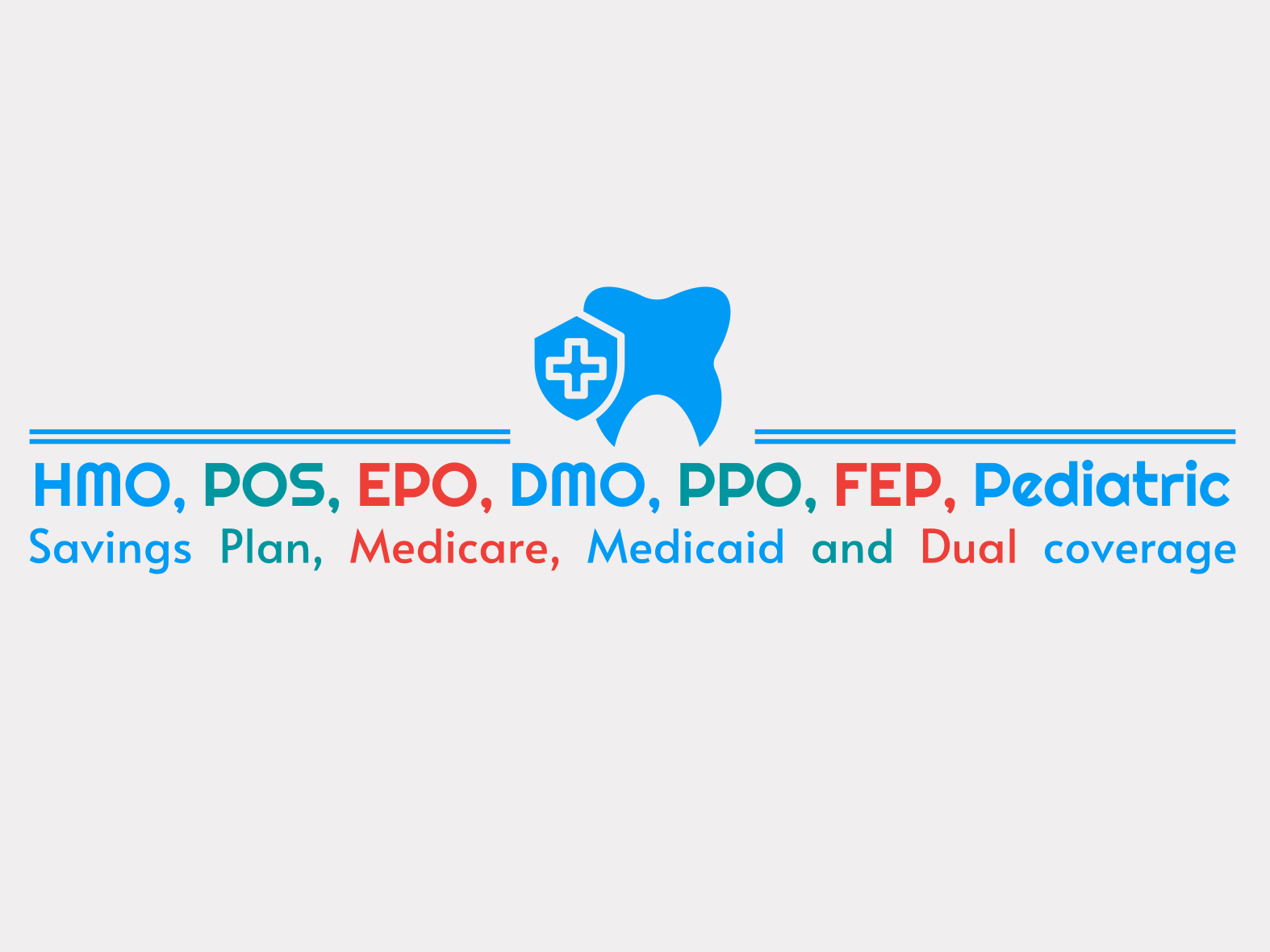Exploring Dental Insurance Plans: Types, Pros, and Cons.
Published on March 6, 2024

Let's explore the difference between HMO, POS, EPO, DMO, PPO, FEP Medical Embedded Dental Rider, Pediatric Dental, Discount or Savings Plan, Medicare, Medicaid and Dual Complete coverage.
Navigating the world of healthcare plans can feel like deciphering a complex puzzle. With options like HMOs, POS, PPOs, EPOs, DMOs, FEP Medical Embedded Dental Rider, Pediatric Dental Rider, Discount or Savings Plans, Medicare, Medicaid, and Dual Complete coverage, it's easy to feel overwhelmed. Fear not! In this comprehensive guide, we'll not only demystify these terms but also uncover their pros and cons to help you make an informed decision about healthcare coverage for both your team and your patients.
This blog aims to provide comprehensive information to help you navigate the complexities of dental insurance. We'll delve into a range of comparisons, such as HMO vs. PPO, HMO vs. DMO, HMO vs. POS, PPO vs. POS, PPO vs. DMO, PPO vs. EPO, EPO plus PPO, PPO vs. Pediatric plans, Federal employees' primary and secondary coverage, Medicare vs. Medicaid, and Medicare vs. Dual Complete, Medicaid vs. Dual Complete. By examining the features, benefits, and limitations of each type of plan, you'll gain a better understanding of which one aligns best with your dental care needs and budget.
Health Maintenance Organization (HMO):
HMO dental plans offer an enticing balance of affordability and comprehensive coverage, making them a popular choice for many insured individuals. Here are the pros and cons of HMO dental policies:
PROS:
- Affordability: HMO dental plans feature lower premiums and out-of-pocket expenses compared to other dental insurance options, easing financial strain while ensuring quality care.
- Comprehensive Coverage: These plans often provide extensive coverage for preventive, basic, and major dental services, including essential procedures like fillings, extractions, crowns, endodontics, and prosthetics.
- Emphasis on Preventive Care: HMO plans prioritize preventive dental services such as routine cleanings, exams, and X-rays, fostering proactive oral health management.
- Wide Availability: HMO dental plans are accessible across most states in the US.
- Predictable Copays: Fixed copays offer transparency and predictability in dental expenses.
CONS:
- Limited Provider Network: Members are restricted to a network of dentists.
- Out-of-Network Limitations: Generally, out-of-network dental services are not covered except in emergencies.
- Gatekeeping Requirements: Some plans require a Primary Care Physician (PCP) and referrals for specialist care.
- Stricter Rules and Limitations: HMO plans often have more stringent regulations than other options.
In summary, while HMO dental plans offer attractive cost-saving benefits and comprehensive coverage, potential limitations regarding provider choices and access to specialized care should be carefully considered.
Point of Service (POS):
POS plans represent a hybrid approach to managed care, blending features from both HMO and PPO plans:
PROS:
- Affordability: Lower out-of-pocket costs for in-network services.
- Negotiated Discounts: Reduced overall healthcare expenses through in-network discounts.
- Flexibility in Specialist Care: Members can seek care outside the network without a referral.
- PCP Coordination: A designated PCP facilitates streamlined care.
- Comprehensive Coverage: Extensive coverage for preventive, basic, and major dental services.
CONS:
- Higher Out-of-Network Costs: Elevated expenses for services outside the network.
- Referral Requirements: Referrals may be needed for specialist care.
- Complexity: Varying levels of coverage and cost-sharing can lead to confusion.
In summary, POS plans offer a blend of flexibility and affordability, though individuals should weigh the pros and cons based on their preferences and cost considerations.
Exclusive Provider Organization (EPO):
EPO dental plans offer a managed care approach focused on cost-effective dental care within a designated network:
PROS:
- Cost-Effective Premiums: Generally lower premiums compared to other options.
- Comprehensive Coverage: Covers a wide range of dental services from preventive to major procedures.
- Direct Specialist Access: No referrals required for in-network specialists.
- Quality Care: Access to a network of high-quality providers.
- Predictable Costs: Fixed copayments or coinsurance make expenses more predictable.
CONS:
- Network Restrictions: Must use in-network providers to receive coverage.
- Limited Provider Options: Fewer choices for dental care.
- Coverage Limitations: May have waiting periods or limited coverage for specialized services.
- Higher Out-of-Network Costs: Out-of-network care can result in higher expenses.
In summary, EPO plans balance cost-effectiveness and comprehensive coverage, though they limit provider choices.
EPO+PPO Plans by Principal Financial:
These innovative hybrid plans allow members to choose between cost-efficient in-network options and the flexibility of a wider PPO network. Different tiers of benefits enable the selection of minimal out-of-pocket expenses with EPO providers or broader choice with PPO dentists, even allowing for non-participating providers when needed.
DMO (Dental Maintenance Organization):
DMO dental plans operate similarly to HMOs, emphasizing preventive care:
PROS:
- Lower Costs: Typically lower premiums and out-of-pocket costs.
- Preventive Care Focus: Emphasizes routine cleanings, exams, and X-rays.
- No Deductibles: No upfront costs before coverage begins.
- No Waiting Periods: Immediate access to basic and preventive services.
- Network of Providers: A primary dentist is chosen from a participating network.
CONS:
- Limited Provider Choice: Restricted to the plan’s network.
- Referral Requirement: Specialist care often requires a referral.
- Out-of-Network Costs: High costs if care is received outside the network.
- Limited Coverage for Major Procedures: Major dental procedures may have reduced coverage.
- Geographical Restrictions: Networks may be limited to certain areas.
Overall, DMO plans are a cost-effective option for those prioritizing preventive care, though they limit provider flexibility.
PPO (Preferred Provider Organization):
PPO dental insurance plans provide coverage through a broad network of dentists with reduced rates:
PROS:
- Extensive Network: Wide selection of dentists and specialists.
- Cost Savings: Discounted in-network rates result in substantial savings.
- Flexibility: Coverage is available for out-of-network providers, though at a higher cost.
- Direct Specialist Access: No referrals needed for in-network specialists.
- Predictable Costs: Fixed copays, coinsurance, and deductibles aid budgeting.
CONS:
- Higher Premiums: Typically higher than other dental insurance options.
- Limited Out-of-Network Coverage: Out-of-network benefits are less generous.
- Preauthorization Requirements: Some procedures may need preapproval.
- Annual Maximums and Waiting Periods: Coverage for expensive procedures can be limited.
- Provider Limitations: Availability might be restricted in rural or underserved areas.
Overall, PPO plans balance flexibility and cost savings, but plan details should be carefully reviewed.
Blue Cross Blue Shield (FEP Comprehensive Medical-Dental Integration):
For federal employees, Blue Cross Blue Shield integrates limited dental coverage within their medical policy:
PROS:
- No Maximum Limits or Deductibles: Consistent access to dental care without annual caps.
- Extensive Network Flexibility: Access to both in-network and out-of-network providers.
- Freedom of Specialist Access: No referrals needed for in-network specialists.
- Nationwide Coverage: Consistent access to care across the United States.
CONS:
- Limited Coverage Scope: Does not cover basic services like fillings or extractions, nor major procedures.
- In-Network Requirement: FEP Basic option plans require choosing an in-network provider.
- Focused Plan Limitations: FEP Blue Focus plans cover only emergency services.
- Coordination of Benefits: Secondary insurance coordination may be required.
In summary, Blue Cross Blue Shield FEP dental coverage offers convenience, flexibility, and nationwide access, though limitations and secondary coordination should be noted.
Pediatric Plans:
Embedded pediatric plans provide comprehensive dental care for children up to age 19:
PROS:
- Complimentary Dental Coverage: Free dental services for members under 19.
- Comprehensive Healthcare: Covers preventive, basic, and major dental services.
- No Annual Maximum Limit: Continuous access to treatments without annual caps.
- National Accessibility: Available throughout the United States.
- Inclusive Provider Network: Coverage for both in-network and out-of-network providers.
- Out-of-Pocket Expense Limit: Caps expenses once the limit is reached.
CONS:
- High Deductibles: Significant deductibles must be met before coverage begins.
- Limited Age Coverage: Coverage ends once individuals reach 19.
- Restricted Provider Options: Primarily offered by select insurers.
In summary, pediatric plans provide a comprehensive solution for children, despite deductibles and age restrictions.
Discount or Savings Plans:
Discount-only dental plans offer reduced rates on dental services rather than traditional coverage:
PROS:
- Affordability: Lower monthly premiums compared to traditional dental insurance.
- No Waiting Periods: Discounts available immediately upon enrollment.
- No Deductibles or Maximums: Unlimited access to discounts throughout the year.
- No Restrictions for Pre-existing Conditions: Discounts apply regardless of dental history.
- Simple Enrollment Process: Straightforward sign-up without complex paperwork.
CONS:
- Limited Provider Network: Fewer participating dentists, especially in rural areas.
- No Insurance Coverage: Members pay the discounted rate out of pocket.
- Quality of Care Concerns: Quality may vary among participating providers.
- No Reimbursements: Direct payment is required at the time of service.
- Not Regulated Like Insurance: Fewer consumer protections compared to insurance.
Overall, dental discount plans can be cost-effective for routine care, but it's important to evaluate the trade-offs carefully.
Medicaid:
Medicaid is a joint federal and state program that helps low-income individuals with medical costs, including dental care in some states.
Dental Coverage:
Coverage varies by state—from comprehensive benefits to emergency-only care.
PROS:
- Provides health coverage to low-income individuals.
- Covers a wide range of services in some states.
- No or low-cost premiums and out-of-pocket expenses.
CONS:
- Eligibility requirements vary by state.
- Some states offer limited dental coverage.
- Provider networks may be limited.
Medicare:
Medicare is a federal program primarily for people aged 65 and older and certain younger individuals with disabilities.
Dental Coverage:
Original Medicare (Part A and B) typically does not cover routine dental care, though some Medicare Advantage plans may include it.
PROS:
- Provides health coverage for eligible seniors and disabled individuals.
- Covers hospital and medical services.
- Medicare Advantage plans can include dental coverage.
CONS:
- Original Medicare generally excludes routine dental care.
- Out-of-pocket costs may be significant.
- Coverage gaps may exist for certain services.
Dual Complete Plans:
Dual Complete Plans are Medicare Advantage plans designed for individuals eligible for both Medicare and Medicaid.
Dental Coverage:
These plans may offer dental benefits beyond Original Medicare, including preventive, diagnostic, and restorative services.
PROS:
- Combines Medicare and Medicaid benefits for dual eligibles.
- May offer additional benefits such as dental, vision, and prescription drug coverage.
- Often lower out-of-pocket costs compared to Original Medicare.
CONS:
- Coverage and benefits vary by plan.
- Provider networks may be limited.
- Plan benefits can change annually during the enrollment period.
In summary, understanding the differences between these various healthcare and dental coverage options—from HMOs to Dual Complete Plans—will empower you to make informed decisions that align with your practice's needs and your patients' care requirements.

